|
A Salute to the Pioneers
by Bob
Brooke
Smack dab
in the middle of the United States stands Harold Warp’s Pioneer Village,
a true salute to America’s pioneers. Jam packed with over 50,000 items
spanning over a 100 years of the country’s history from approximately
1850 to 1950 and a bit beyond, it’s a testament to not only one man’s
passion for collecting but to his determination to show the progress the
country has made over that time.
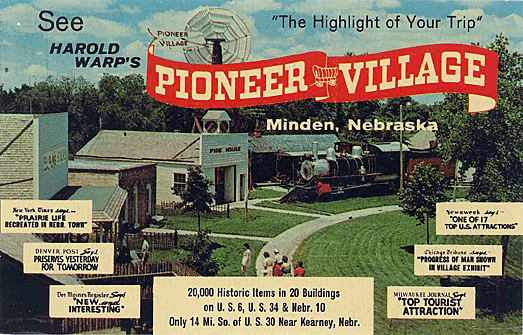
Midwesterners
most likely purchased a good many of the items on display through the
Sears Catalogue, making this museum a visual representation of American
life through the items people owned.
Harold Warp was born poor, in a Nebraska sod house. Later, he invented
plexiglas and became a millionaire. Over the years, he created what can
only be described as a mini Smithsonian, containing everything from
antique and vintage telephones to slot machines to classic cars to all
sorts of household and farm items.
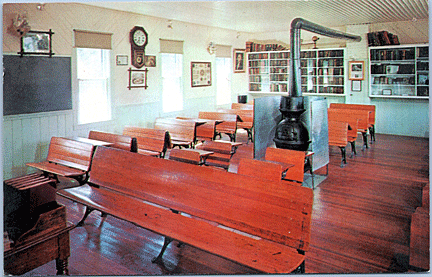 The
museum sprawls through 28 buildings, a dozen of which Warp purchased and
brought to the site in Mendlin, Nebraska. The very first building he
purchased was the schoolhouse he attended as a child. Along with it, he
bought, his hometown’s train depot, church, and nine other structures. The
museum sprawls through 28 buildings, a dozen of which Warp purchased and
brought to the site in Mendlin, Nebraska. The very first building he
purchased was the schoolhouse he attended as a child. Along with it, he
bought, his hometown’s train depot, church, and nine other structures.
Then he moved them to an artificial town square and opened it as an
attraction—Harold Warp's Pioneer Village—in 1953. The Warp Family sod
house was long gone, so he had a replica built of real sod and placed it
only a few feet away from America's oldest carousel, perhaps fulfilling
one of Harold's childhood dreams.
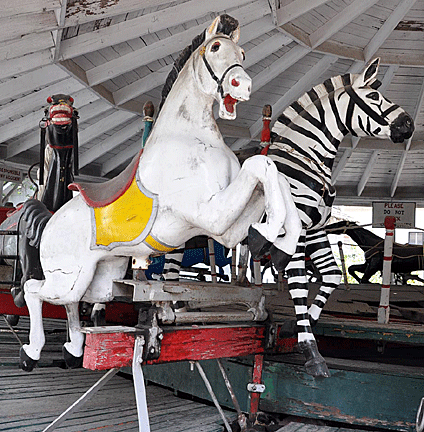
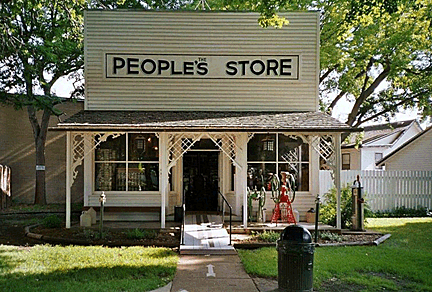 A
peek inside a harness maker's workshop reveals walls covered in bridles,
halters, harnesses, and reins. Shelves filled with the tiny bits and
necessities of the job of the 19th and early 20th-century harnessmaker.
A large, antique sewing machine stands ready to stitch. A
peek inside a harness maker's workshop reveals walls covered in bridles,
halters, harnesses, and reins. Shelves filled with the tiny bits and
necessities of the job of the 19th and early 20th-century harnessmaker.
A large, antique sewing machine stands ready to stitch.
And on the village green stands The People’s Store, a replica of a store
that originally stood in Stamford, Nebraska. It’s interior is filled to
the brim with all the items that would have been sold there.
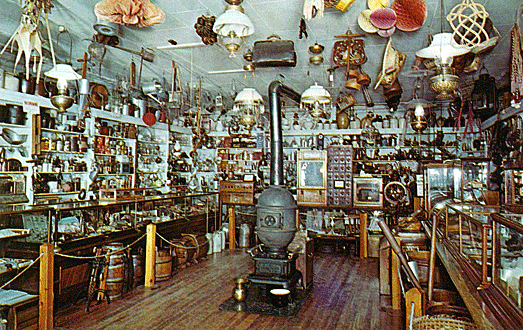
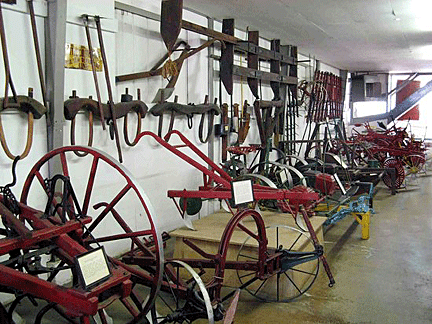 Warp
surrounded his village with 16 exhibit halls, filling them with over
50,000 historical objects, everything from President Lincoln's sugar
bowl to trolley cars. The Village doesn't try to impress visitors with
fancy displays. It is all about the items, themselves, and their place
in history, so Warp displayed most of them in chronological order. Warp
surrounded his village with 16 exhibit halls, filling them with over
50,000 historical objects, everything from President Lincoln's sugar
bowl to trolley cars. The Village doesn't try to impress visitors with
fancy displays. It is all about the items, themselves, and their place
in history, so Warp displayed most of them in chronological order.
He sorted his collection into groups and placed them in buildings, each
with a given theme—farm equipment,
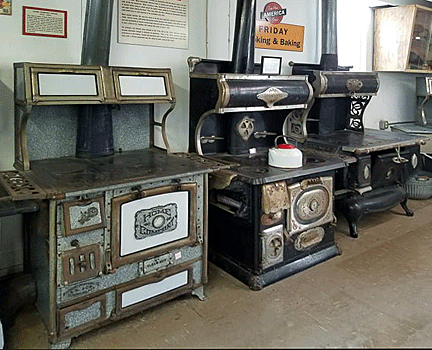 airplanes,
trucks, home appliances, etc. Visitors can easily see the evolution of
such things as bathtubs, cash registers, washing machines, pocket
watches, even fishing lures. One exhibit hall showcases the progress in
the interior design of kitchens and living rooms from 1830 to 1980.
Another displays rows and rows of kitchen stoves, from old cast iron
wood stoves to more current electric stoves. airplanes,
trucks, home appliances, etc. Visitors can easily see the evolution of
such things as bathtubs, cash registers, washing machines, pocket
watches, even fishing lures. One exhibit hall showcases the progress in
the interior design of kitchens and living rooms from 1830 to 1980.
Another displays rows and rows of kitchen stoves, from old cast iron
wood stoves to more current electric stoves.
Some might find the Pioneer Village to be somewhat cluttered. But that’s
part of its charm. It’s not pretentious. Florescent lights shine down on
the displays, giving an eerie warehouse feeling. It’s an overwhelming
array that can take up to a day or more to see completely.
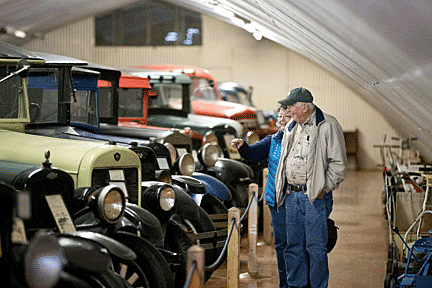
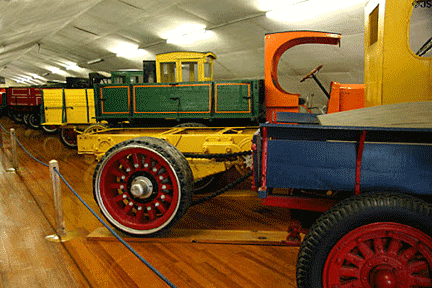 Items
in the collection include antique and vintage automobiles from 87
different manufacturers, the first motorhome, the first tractor, trucks
of every description, ice making tools and machinery, even a railroad
engine—No. 967—that once ran through town. Items
in the collection include antique and vintage automobiles from 87
different manufacturers, the first motorhome, the first tractor, trucks
of every description, ice making tools and machinery, even a railroad
engine—No. 967—that once ran through town.
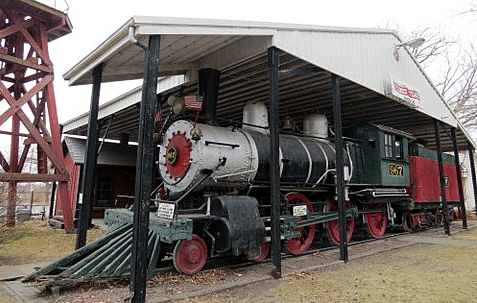
Visitors
will discover Grover Cleveland's presidential desk, the first consumer
cordless phone, and a piece of tinfoil from Thomas Edison's original
phonograph. You can see America's first jet fighter, Chicago's last gas
street lamp, and a pouch with undelivered letters from a dead Pony
Express rider, all scattered through the buildings of this artificial
“village.”
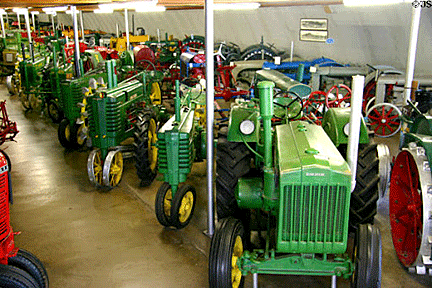 One
building, the Hobby House, is the only one in which items aren’t
displayed chronologically. Collections of Barbie dolls, salt shakers,
ashtrays, pencils, buttons, liquor decanters, mechanical banks, fountain
pens, spittoons, nightcaps line the shelves and walls. One
building, the Hobby House, is the only one in which items aren’t
displayed chronologically. Collections of Barbie dolls, salt shakers,
ashtrays, pencils, buttons, liquor decanters, mechanical banks, fountain
pens, spittoons, nightcaps line the shelves and walls.
But mixed
in amongst the chaos are Warp;s personal memorabilia—his color TV, his
car, he personal airplane, his yacht, and even his son’s hail-dented
1972 Ford Pinto and his wife’s contact lenses.
Not only did Warp purchase and collect all the items on display, he
wrote extensive descriptions for each, indicating something about the
item’s history.
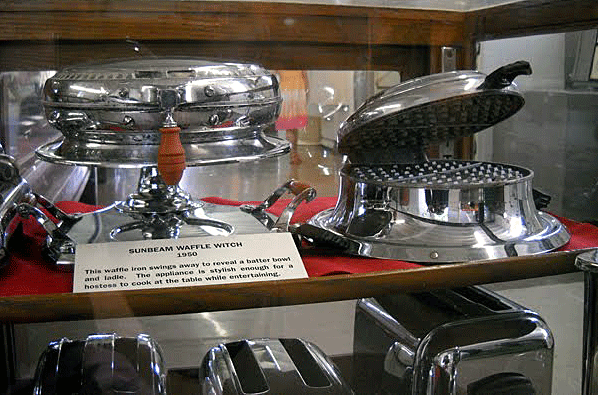
And if wandering the exhibit halls and historic buildings becomes too
much, visitors can stroll onto the village green where they can play a
game of checkers on the porch of The People’s Store, a replica of one
that stood in Stamford, Nebraska. For those who can’t tear themselves
away, there’s always another day.
<
Back to More Antiques to View
Next Article > |
